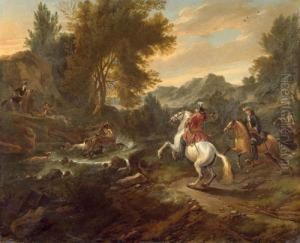Jan Wijck Paintings
Jan Wijck, also known as Jan Wijk or Jan Wyck, was a Dutch Baroque artist who is primarily known for his battle scenes and equestrian portraits. Born in Haarlem, Netherlands, in 1642, Wijck was part of an artistic family; his father, Thomas Wijck, was also a painter known for his genre scenes and depictions of alchemists' studios.
Jan Wijck's early training was with his father, and the influence of Thomas's work can be seen in Jan's attention to detail and his use of light and shadow. After his initial training, Wijck moved to England around 1660, which was a significant period in British history known as the Restoration, when Charles II was restored to the throne. During this era, there was a resurgence of patronage for the arts, and Wijck found a receptive audience for his work.
In England, Wijck became known for his military and historical scenes, which were in demand in the wake of the English Civil Wars and during the reign of Charles II. He painted the Battle of Seneffe and the Battle of the Boyne, among other historical events. His work was characterized by dynamic compositions and a keen sense of movement, which brought his battle scenes to life. Jan Wijck was also skilled in depicting horses, and his equestrian portraits show a deep understanding of the animal's anatomy and behavior.
Despite his Dutch origins, Wijck's contribution to British art was significant, and he is often associated with the development of British military and equestrian painting. His influence is seen in the work of later British artists who specialized in similar subjects. Wijck's paintings can be found in various collections, including the National Army Museum in London and the Royal Collection.
Jan Wijck continued to work and live in England until his death in 1702. His legacy is that of a painter who was able to capture the grandeur and drama of his time, providing a visual record of historical events and the nobility of the horse in warfare and sport.
